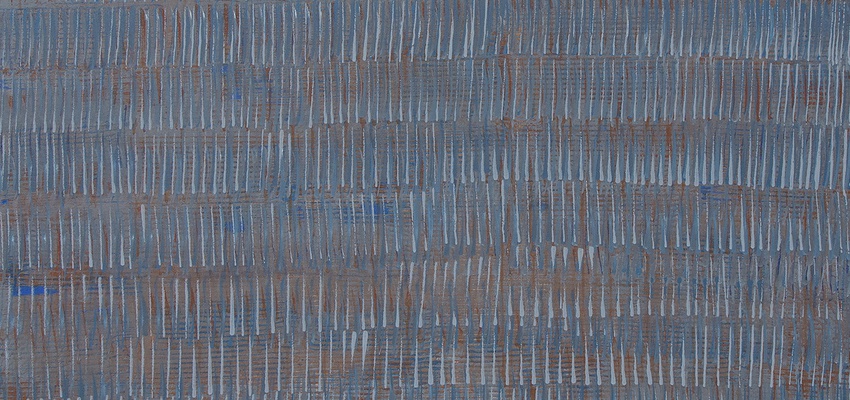Seen through the focus of 3 key ‘moments’ in his practice: Aekyadic (1970s-present) Neo-expressionist (1980s) and Phoenician (1990s-2000s). It also explores Abdell’s abiding fascination with the origins and evolution of written and spoken language throughout the Mediterranean – from ancient Phoenicia to Latino and international Hip-Hop - reflecting the artist’s cosmopolitan spirit. An intensely driven and prolific artist, Abdell’s work spans painting, drawing, tapestries and sculpture, permeated with the same obsessive interest in language and animated by the phonetic games with which he ‘emancipates’ and reimagines written alphabets.
Abdell comments; ‘My sustenance as an artist is the complicated balance between the euphoria of the unknown and that which is known and their imminent application when conceiving a sculpture’. Further, Abdell’s work plays with and detonates our accepted reading of history and culture – ever the provocateur, he states, ‘I want to fuck-up the archaeologist!... They find this and ask: “What the hell is this?” This is Phoenician but it has Punic letters on it. “What’s going on here?” I’m mixing all these images, trying to bring them all together’.
The three distinct series of works- Aekyadic, Neo-expressionist and Phoenician are presented here as separate rooms, or three periods of a hectic journey: substituting the illegal highs and drugs of the ‘traditional’ trap house with the hallucinatory visual and conceptual intricacies of Abdell’s hybrid alphabets. The Curator, Morad Montazami, comments: ‘A whole alphabet of hybrid motifs become mixed up, as a DJ scratching deconstructs sound. A “reconstructed” Trap house is everything that Douglas Abdell does: to penetrate a certain cultural space or form of writing in order to rework until explosion and reconstruction... as an infinite, Babelian and anarchic process made of electro-magnetik vibrations.
Abdell came to prominence in the New York art scene of the late 1970s, during the heady period which also saw the emergence of street art, block-parties and the hip-hop scene. Even if his sculptures were generated in a totally autonomous ecosystem from these trends, the cultural landscape of the time is apparent in works by Abdell of this period, notably the Aekyad sculptures which were installed on Park Avenue in 1979. These black Aekyad abstract sculptures seem to bely the heft of the industrial materials in which they are created, suggesting instead the ecstatic speed, electricity and deft geometric movements of the underground cultures of the time.
By 1983, New York had become a ‘laboratory’ for Abdell and the substantial permanence of the steel Aekyad sculptures began to give way to work created from salvaged ‘junk’ materials, including posters, packaging and newspapers scrounged on the neighbouring Latino and Chinese streets. The resulting ‘Neo-Expressionistic’ painting-collages and totem sculptures are a melting-pot of language and visual culture – but also a blending of dramatically different environments; the street, the gallery, the studio, the archaeological site, the hip-hop party; Chinatown and the ruins of Baalbek all appear in these works.
In 1984 Abdell published his wild lettrist and numerological manifesto, MIRROR MAGNETIK INTERVAL (a collaboration with his partner of the time Begonia Korta-Zaharra). Meditating on the emancipation of numbers and letters in the introduction, Abdell comments; “The sickness of our time is that we are educated to separate rather than connect. Be it, for example, with numbers (mathematics, chemistry, physics) or letters (philosophy, literature, art)...I will never be able to study a number without thinking of it as an expanding function, or forgetting where it comes from and where it’s going. The principle of motion is connected to everything. Nothing exists without a relation to something else.”
In the early 1990s Abdell chose to largely turn his back on the fame which he had enjoyed in New York, exhibiting alongside artists including Jean-Michel Basquiat and Louise Nevelson, with a move to relative obscurity in Madrid and then Malaga, the beginning of his ‘Phoenician’ period of works. In part an exploration of his Mediterranean roots, these works begin with his “Fourth Punic War” to offer a very long-view of the geopolitics behind the Lebanon / Palestine / Israel crisis and the ongoing migratory disaster - seen through the mixed up (and invented) Etruscan and Phoenician symbols that populate these works.
Morad Montazami comments; ‘These works express ironic feelings towards the national Ego behind any monument or cultural emblem. They are like makeshift vestiges of a reenacted archeology, or sculptural chanting songs for imagined gods.... showing their Phoenician and Arabic hieroglyphs as a sacred column, holding secret messages to be deciphered by the viewer.’
The exhibition is completed with works from his recent ‘Phoenician’ M=AGUA series (late 1990s-early 2000s). Featuring numerous stone or marble works placed individually on a robust wooden platform, M=AGUA opens a new dialectic of materials: between wood and stone, organic and mineral, earth and water. M=AGUA references water and the Phoenician invention of the letter ‘M’ – inspired by the waves of the Mediterranean Sea - but also the tragic upturned rafts of the contemporary migration crisis.
As with so much of Abdell’s work, these enigmatic sculptures stand as symbols of hope; ‘connectors’ between different continents, people and histories, inviting us to speak, travel and dream without borders.
For further information about AB-ANBAR:
Azadeh Zaferani: azadeh@ab-anbar.com: 44 (0) 7747581470
For press Enquiries:
Celia Bailey: bailey_celia@hotmail.com: 44 (0) 7930 442 411





